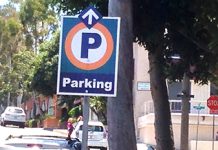By Jennifer Erickson | LB Indy
If all goes according to plan, the Festival of Arts will open their 2015 season with a brand new look, thanks to the City Council’s unanimous approval Tuesday of permits for proposed renovations to the public park.
Constructed of plywood and foam 14 years ago under a temporary building permit, “the vertical facade is old and tired and in need of replacing,” said FOA president Fred Sattler. But what began as a simple wall replacement “grew in scope and complexity, much to our surprise and delight, to encompass the entire front of the property,” he said.
In addition to a new facade, the current project now includes a reoriented entrance into the grounds, an entrance canopy, a pedestrian promenade, seating elements and added landscaping, according to the staff report.
“Today, the frontage on Laguna Canyon Road is not a friendly place, nor does it match the quality of Laguna…,” said Jay Bauer of Bauer Architects, part of the project’s design team that includes Lucas Shellhammer of landscape architects Spurlock & Poirier, and Pat Fuscoe of Fuscoe Engineering.
The space was reimagined to create a sense of place, a visitor experience, and a sense of arrival, Bauer said. He described the proposed drop-off, pick-up and loading area within the entry court and a serpentine facade that recalls the forms and materials of the canyon and provides identity, security, and noise and dirt mitigation.
Their vision reinforces “the connection between art and landscape, between people and nature and between the village and the canyon,” he said.
While six arts organizations embraced the project, about half of the public speakers found fault with one element of the remodel: namely its removal of 13 public parking spaces.
Representatives from the Sawdust Art Festival, the Festival of Arts Foundation, Laguna Playhouse, Laguna College of Art & Design, Seven Degrees event space, and Art-A-Fair all endorsed FOA’s makeover. Additionally, FOA exhibitor Cathy Jones presented a petition with 400 artists’ signatures in support of the renovations. “We are hugely proud of what we do, but not so proud of our front door,” she said, expressing their enthusiasm for the envisioned entry.
Village Laguna’s president Ginger Osborne lauded the design, but objected to the elimination of parking spaces. What’s more, the Festival treats those spaces as private spaces, blocking them off for executives and board members in the summer, she said.
In order to provide a more pedestrian-friendly promenade, the project removes 13 existing parking spaces on a frontage road. Because the spaces are neither considered required parking nor a condition of its lease from the city, FOA has no legal obligation to replace them, according to the staff report. However, because the Coastal Act seeks to maximize public access through the availability of parking, the city generally strives to maintain visitor-serving parking. To that end, the 17 spaces created on Cliff Drive when a portion of it was converted to one-way traffic, could be considered sufficient to offset the eliminated festival spaces, the report says.
That substitution “is a deal-breaker for me,” said former Council member Verna Rollinger, who suggested removing that area from the project or finding alternate replacement parking.
“I feel like these issues come up and we flip flop,” said nursery owner Ruben Flores, who questioned why parking-space replacement, so central to village entrance debates, lost its importance for this discussion.
Johanna Felder suggested replacing the lost spaces by installing 13 parking lifts in the lot behind Laguna Playhouse.
Even so, “I think it’s a project that is deserving of moving ahead right now,” said Mayor Pro Tem Bob Whalen, whose wife is a festival exhibitor. Despite the debate about needing to replace parking spaces one for one during the village entrance discussion last year, he said that the city acknowledged that one for one replacement was not necessarily required by the California Coastal Commission. The agency also looks at the overall mix of parking capacity downtown, which includes increased capacity from implementing measures in the city’s parking management plan, he said.
Whalen said he had “no concern” with the city swapping those parking spaces for the proposed improvements.
“I think we ought to be creating pedestrian friendly spaces, and this is one, and you create that by getting rid of automobiles…so I am a strong, strong supporter of this project as designed,” he said. “I want to see this project proceed. I want to see it start building in October, and we can all enjoy it this time next summer.”
The rest of the Council concurred.
When the Festival considered relocating to another city in the ‘90s, part of new lease negotiations included making improvements in the grounds, said Mayor Elizabeth Pearson, applauding the organization for their perseverance in coming up with an appealing plan and the $3.5 million to foot the bill. “You haven’t given up and we’re here and it’s time,” she said.




